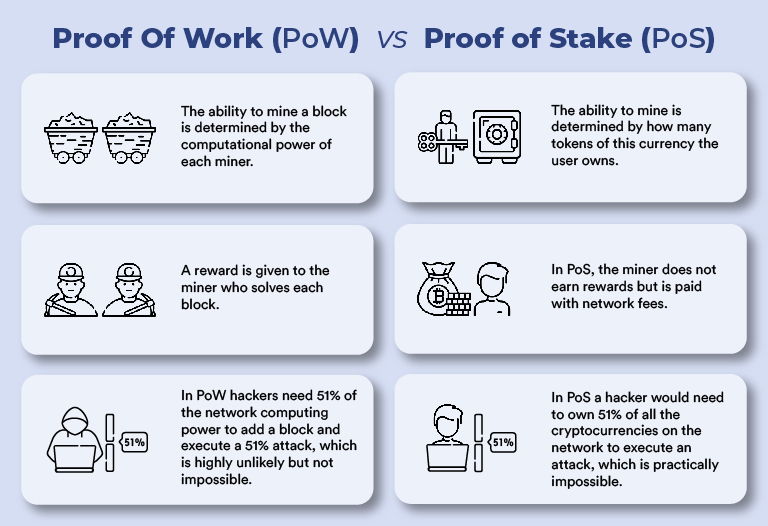
Table of Contents
ToggleWhat is cryptocurrency stacking: definition
If you have read somewhere the word ‘staking’ but don’t know what it refers to, don’t panic. Today I will explain what cryptocurrency staking is, how it works and how to earn with it.
But, before I go any further, I’ll give you two hints….
- Proof of Work
- Proof of Stake
Sound familiar?
Well, to understand what staking is, first you have to know that some cryptocurrencies like Bitcoin pay their miners (who are no more and no less than the master nodes of the network), with rewards to protect their networks. To do so, many coins like Bitcoin use a mining algorithm called Proof of Work (PoW).
However, PoW-based mining has some disadvantages. One example is high energy consumption and constantly increasing costs of mining equipment.
This is why Proof of Stake was born, an alternative mining algorithm, which provides a consensus mechanism that allows users to protect cryptographic networks with minimal energy consumption and difficulty.
So, the word Staking comes from the PoS algorithm and in the following paragraph we will see how it works, how it differs from the PoW algorithm and what are its benefits.
How does cryptocurrency staking work?
The Proof-of-Work (PoW) based consensus mechanism works in this way: miners have to solve with powerful equipment, complex mathematical puzzles to validate blocks on the blockchain, thus ensuring the security of the network in exchange for a reward.
With staking, on the other hand, the user generally buys a cryptocurrency to lock it (hold it) in a wallet or smart contract, with the purpose of receiving a commission (fee) as a reward.
The Staking process is similar to the cryptocurrency HODL, except that in staking the staked cryptocurrencies are locked and cannot be used freely.
Once a user’s participation is blocked, users can vote to approve transactions.
Please note that the rules of participation vary by network and in many cases users do not have to vote and the transaction validation process is done automatically.
Once the transactions are validated, the network rewards randomly with a participation prize, and it does so taking into account the user’s wealth, i.e. depending on how many cryptos of that coin the user owns.
The amount of the reward is variable and depends on the total number of stakers participating in the process.

As you have seen in the image above, the PoW and PoS mining algorithms have some important differences:
- Mining capacity: In the Pow mechanism, the capacity to mine a block is determined by the computational power of each miner, while in the PoS mechanism it is determined by the number of tokens owned by the user.
- Rewards: In Pow, the miner who solves each block of the blockchain is rewarded with a reward. In the PoS the miner who has his cryptocurrencies blocked (‘staked’) in a wallet, when validating transactions, will randomly earn the network fees (fee).
- Network security: In the PoW system, hackers need 51% of the computing power of the network to execute an attack, which is highly unlikely, but not impossible. In contrast in the PoS system a hacker would need to possess 51% of all cryptocurrencies in the network to execute an attack, which is practically impossible.
Types of staking
There are two types of staking: centralized and decentralized.
CENTRALIZED STAKING
Centralized staking is when you use blockchain providers that offer the possibility to stake your cryptocurrencies. In this case, the user transfers his funds on the exchange and the provider will take care of everything else.
This means that the staking occurs outside the user’s own personal wallet and the user gives the staking provider full control of his funds. Thus, all earned rewards will be deposited into the account created on the exchange rather than into your personal wallet.
The downside is that, in case of theft of the platform, the user could lose all his assets.
DECENTRALIZED STAKING
In contrast, decentralized staking, or dStaking, does not use a third-party exchange for staking cryptocurrencies. This means that the user retains control of their private keys and ownership of the assets, ensuring greater protection against fraud.
Advantages of cryptocurrency staking
- As you can see, Staking is a much easier process than Pow algorithm-based mining and is a great passive income opportunity for users who want to support crypto networks and, at the same time, earn money without intervention.
- Users do not have to have super powerful and expensive equipment, nor do they need technical knowledge, as is the case with the Pow-based algorithm. Moreover, they do not have to spend large amounts of energy.
- In addition, the coins placed by users on the blockchain not only help validate transactions, but above all, they help make the blockchain more secure and keep it running.
This happens because when a user bets and locks their funds in a smart contract or wallet, it will help an attacker not have enough cryptocurrencies (51% of the entire network) to be able to execute a 51% attack.
This makes users rewarded for good behavior, making the network much more secure than in the proof-of-work mechanism.
How to Staking cryptocurrencies?
If you want to staking cryptocurrencies and start earning some extra income, you will have to follow a few simple steps:
- Choose the cryptocurrency with PoS consensus system: choose, among the available PoS cryptocurrencies, a cryptocurrency that catches your attention.
- Download the wallet: I advise you to use a software wallet to store the funds used for staking. In the next paragraphs I will give you a list of the best wallets for staking, although each crypto has its own free wallet.
- Study the minimum requirements that each crypto asks for: it can be a minimum number of coins needed to bet, having a connection to the h24 network, or a verification of your identity.
- Decide which hardware to use: You can use a desktop PC with a good GPU or CPU.
Start staking: once you have configured your wallet, you can start betting.
Where and how to do cryptocurrency staking?
You can bet crypto both online and offline.
- If you decide to bet offline, you will have to use your PC as a validator node or delegate node. Some cryptocurrencies require that the node you use meets some minimum technical requirements. Generally master nodes are created either with a wallet desktop on your computer or on a VPS (Virtual Private Server).
- If you decide to do it online, you can choose between staking on exchange platforms or using a staking pool.
Staking on exchange platforms
If you don’t want headaches and prefer to have an external platform handle the management of transactions, the wallet and the security of your private keys, then the best solution is to staking on an exchange platform.
Below you will find a list of the main exchanges where you can staking cryptocurrencies online:
- Coinbase
- Binance
- Kraken
- Bitfinex
- Huobi
- OKEx
Most of these platforms offer staking services for a wide range of cryptoassets while some only support their associated projects. Binance currently offers the largest variety, with a total of 42 cryptocurrencies available for staking.
Pool of strike
Another option for earning passive income through cryptocurrency staking is by joining a pool.
Staking in a pool or group allows you to join with other crypto asset holders to combine computing resources and increase your chances of receiving rewards. Although staking pools generally produce smaller payouts, as the reward must be divided among the participants in the group, working in a team will make it easier to earn rewards.
Pool of Stake is an example of a staking pool that you can use.
REQUIREMENTS FOR STAKING CRYPTOCURRENCIES
Whichever method you choose, before you start betting cryptocurrencies, it is very important that you check that the blockchain uses the PoS algorithm. Then you should inform yourself about the general conditions, which the platforms you are going to bet on, ask from their users.
Some platforms may ask for the following:
- The wallet must support staking.
- The wallet must be connected 24 hours a day if you are staking online.
- Coins have to be locked in the wallet for at least a couple of days before you can receive a reward.
- You must have a minimum amount of cryptocurrencies locked in the wallet.
Note that each blockchain has different rules for its cryptos. Therefore, it is advisable to find out specifically for each token what restrictions apply.
Which Crypto to bet on?
More and more cryptocurrencies that use the PoS algorithm are joining the crypto universe and below I will show you a list of the most popular ones for staking,
- Ethereum ( has started using the PoS algorithm with the release of Ethereum 2.0 on December 2, 2020.)
- EOS
- Tezos
- Tron
- QTUM
- OmiseGo
- Cardano
- Dai
- Polkadot
- Komodo
- NEO
- ONT
Most of the listed coins can be purchased at Bitnovo at the best price on the market.
Wallets for cryptocurrency staking
Most PoS cryptographic tokens have their own wallet designed for staking.
However, there are a couple of wallets that support multiple tokens.
- Atomic Wallet supports 15 token types, including Tron, NEO, Tezos, OmiseGo and Cardano.
- Trust Wallet, allows the staking of 9 types of tokens, among them: Tezos, Tron, Cosmos, VeChain. It also offers a staking calculator, very useful when evaluating the possible benefits of the investment.
There are also Cold wallets like Ledger that provide a staking platform. The negative note is that not all PoS based cryptos support cold or offline staking.
Useful resources for cryptocurrency staking
As the popularity of staking increases, so do the resources that help users undertake this activity.
So, before you get started, I advise you to take a look at these useful resources that will make it easier to start staking cryptocurrency.
- Stakingrewards: is a data provider for crypto staking and growth tools. At the moment it allows you to track 164 assets from 1782 qualified providers and with an average reward rate of 17.28%. In addition, their online calculator allows you to calculate your potential earnings.
- Staking Profit Calculators: Most cryptocurrency wallets also provide a staking calculator that allows you to enter the amount of assets you wish to bet and a time frame to get an estimate of the returns.
Here is a list of calculators for the most popular PoS tokens:
Now you have all the information and resources to start staking Cryptocurrencies. You just need to jump into the ‘pool’ 😉 Are you up for it?






